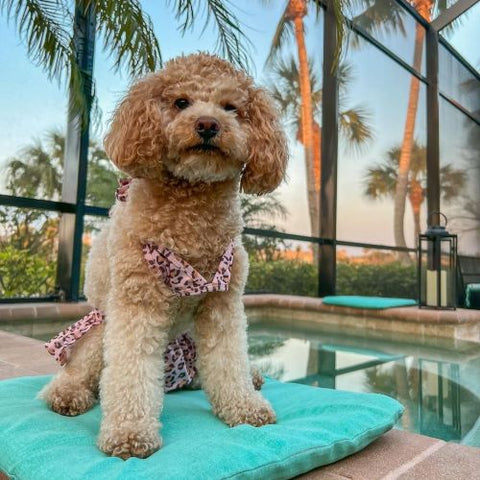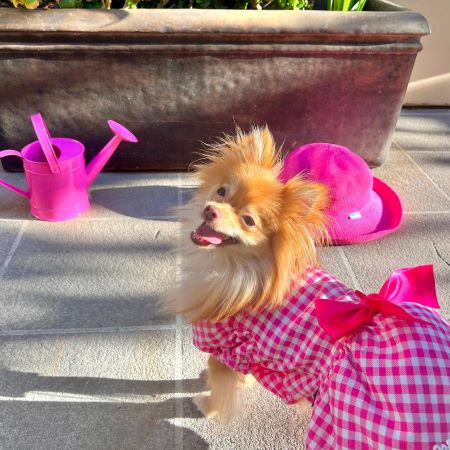¿Con qué frecuencia debes lavar a tu perro?
Mantener a tu perro limpio y aseado es fundamental para ser un dueño responsable. Sin embargo, a la hora de bañarlo, muchos dueños se preguntan con qué frecuencia deben bañarlo. Si bien cada perro es diferente, existen algunas pautas generales que puedes seguir para determinar la frecuencia óptima de baño para tu cachorro. Factores como la raza, la edad, el largo del pelaje, la sensibilidad de la piel y el nivel de actividad influyen. El baño te brinda la oportunidad de conectar con tu perro, revisarlo... parásitos o problemas de la pielY, por supuesto, les dará un olor fresco de nuevo. Seguir rutinas de baño adecuadas puede beneficiar enormemente a tu... La salud y la calidad de vida del perroEste artículo cubrirá los factores que determinan la necesidad de bañar a su perro, las señales que indican que es hora de bañarlo, consejos para un baño seguro y las ventajas que le ofrece.

Los múltiples beneficios de bañar regularmente a tu perro
1. Mantiene su pelaje limpio Los baños regulares eliminan la suciedad, los residuos y las bacterias que causan mal olor del pelaje de su perro para mantenerlo con un aspecto y un olor fresco y limpio.
2. Promueve una piel sana El baño se lleva alérgenos, el exceso de grasa y las células muertas de la piel al mismo tiempo que proporciona hidratación para nutrir la salud de la piel.

Instagram: honeytheminipoo
3. Reduce la caída del cabello El movimiento del baño ayuda a aflojar el cabello viejo que luego se puede enjuagar en lugar de terminar esparcido por toda la casa.
4. Revela problemas de la piel La hora del baño te da la oportunidad de inspeccionar si tu perro tiene picaduras, puntos calientes, erupciones u otros problemas en la piel que pueda tener.
5. Previene los parásitos Un enjuague minucioso puede ayudar a eliminar los huevos o larvas de parásitos para evitar problemas como pulgas, garrapatas o sarna en el futuro.

Instagram: wakanda_shihtzu
6. Controle el olor a perro Eliminar el sudor, los aceites y la suciedad acumulados en el pelaje hace que el perro huela más fresco durante más tiempo entre baños.
7. Alivia la picazón Para los perros con alergias, los baños medicados pueden aliviar y calmar la piel irritada y con picazón.
8. Fortalece su vínculo Para la mayoría de los perros, la hora del baño es un momento positivo a solas con su amado dueño.

Instagram: iggychelseaandme
9. Reduce la ansiedad Algunos perros se vuelven más relajados y menos temerosos de los baños cuando estos forman parte de una rutina constante.
¿Cuáles son los factores que determinan la frecuencia con la que los perros necesitan bañarse?
Hay algunos aspectos clave que determinan la frecuencia con la que tu cachorro necesita enjabonarse:
- Raza: ¡Algunas razas tienden a oler más! Perros como retrievers, basset hounds, caniches y cocker spaniels producen naturalmente más grasa, por lo que necesitan baños más frecuentes. Las razas con piel más seca, como los galgos o los dálmatas, solo necesitan baños ocasionales.
- Edad: Los cachorros y los perros mayores tienden a necesitar baños menos frecuentes, quizás solo unas pocas veces al año, ya que su piel es más sensible. Un baño excesivo puede causar sequedad o irritación. Los perros adultos necesitan baños regulares según otros factores.

Instagram: deo_piper_cavoodles
- Largo del pelaje: Los cachorros de pelo corto suelen necesitar un baño cada 4-6 meses. Su pelaje retiene menos suciedad y mugre. Las razas de pelo largo necesitan un baño con más frecuencia, aproximadamente cada 3 meses, para evitar enredos y nudos.
- Nivel de actividad: Los perros que pasan más tiempo jugando al aire libre y metiéndose en cosas necesitan más baños para eliminar toda la suciedad, el barro y la mugre. Los perros de interior podrían necesitar solo unos pocos baños al año.
- Afecciones cutáneas: Los perros con alergias, infecciones u otros problemas cutáneos pueden necesitar baños medicados hasta una vez por semana. Siga siempre las recomendaciones de su veterinario para perros con problemas cutáneos.
Cómo Dile que es hora de bañar a tu perro
1. Si notas grumos de barro o tierra pegados en su pelaje, especialmente alrededor de las patas, la pancita o el trasero, ¡es hora del baño! A los perros les encanta ensuciarse cuando juegan al aire libre.
2. ¿Alguna vez has olido a tu cachorro y has notado un fuerte olor a perro incluso después de cepillarlo? Ese olor apestoso significa que es hora de eliminar la grasa y la suciedad acumuladas en su pelaje.

Instagram: friendly.faith.the.morkie
3. ¿Últimamente encuentras pelo de perro por toda tu ropa y muebles? La caída abundante de pelo es una señal de que bañarlo ayudará a aflojar y enjuagar el pelo muerto.
4. ¿Su pelaje se ve grasiento, lacio y sin brillo incluso después de cepillarlo? Un poco de aceite le da un brillo saludable, pero demasiado le da un aspecto sucio. El baño eliminará el exceso de grasa y le devolverá ese pelaje brillante que tanto desea.
5. ¿Observa caspa o zonas rojas e irritadas en la piel? Esto podría indicar un problema cutáneo que requiere un baño medicado para aliviarlo.

Instagram: hattiemaethemorkie
6. ¿Sorprendes a tu perro lamiéndose o rascándose obsesivamente la piel y el pelaje? Esto suele ser señal de molestias causadas por suciedad, plagas o irritación cutánea que un buen baño puede ayudar a eliminar.
¿Con qué frecuencia debes bañar a tu perro?
A la hora de bañar a tu peludo amigo, cada perro es diferente. Pero aquí tienes algunos consejos generales sobre la frecuencia de baño para perros adultos:
- Perros adultos con pelaje normal: Báñelos cada 3 a 6 meses. La mayoría de los perros adultos sanos solo necesitan unos pocos baños al año para mantener su piel y pelaje en buen estado. Bañarlos demasiado puede resecarles la piel.
- Cachorros menores de 6 meses: Báñelos cada 3 meses. Los cachorros tienden a ensuciarse más rápido, pero bañarlos demasiado puede irritar su piel sensible. Bájelos solo una vez por temporada.

Instagram: matildarosegoldendoodle
- Perros mayores de 10 años: Báñelos cada 2-3 meses. Los perros mayores suelen ser menos activos, pero podrían necesitar más baños para eliminar el pelo muerto y las células cutáneas a medida que su pelaje y piel cambian. Sin embargo, no se exceda.
- Perros con problemas de piel: Frecuencia recomendada por el veterinario. Los baños medicados suelen recetarse para afecciones cutáneas como alergias o infecciones.Siga las pautas de su veterinario.
- Perros de pelo largo: Báñelos cada 3 meses. Su pelaje grueso retiene más suciedad y grasa, por lo que necesitan un poco más de baños que los cachorros de pelo corto.

Instagram: friendly.faith.the.morkie
- Perros activos y con barro: Báñelos cada 2 a 4 meses. Los perros que pasan más tiempo jugando al aire libre podrían necesitar más baños para mantenerse limpios. Preste atención a la piel seca.
Estos consejos son pautas útiles, pero puede que tengas que adaptarlos según las necesidades únicas de tu perro y su respuesta al baño. Presta atención a su piel y pelaje para encontrar el horario de baño ideal.
¿Bañar a tu perro? Sigue estos consejos
1. Use champú para perros: El champú para humanos está formulado con un pH inadecuado para la piel de un perro y puede causar sequedad, irritación y daño cutáneo con el tiempo. Opte siempre por un champú suave para perros, recomendado por veterinarios y elaborado específicamente para su piel. equilibrio del pHBusque ingredientes calmantes como avena, aloe y vitamina E.

Instagram: all_cali_cuteness
2. Use agua tibia: Evite usar agua caliente, ya que puede quemar la piel sensible de su perro. Sin embargo, bañarlo con agua tibia ayuda a relajar la tensión muscular, aflojar la suciedad y los residuos, y evita que se enfríe demasiado durante el baño. Compruebe que el agua esté agradablemente tibia, no caliente, en su muñeca antes de mojar a su perro.
3. Mantenga el agua fuera de los ojos y los oídos: Use bolitas de algodón, una toallita o la mano ahuecada suavemente sobre las aberturas del canal auditivo para evitar que entre agua durante el baño. Tenga mucho cuidado de no dejar que el champú o el agua entren en sus ojos, ya que pueden causar ardor e irritación. Limpie suavemente los ojos con un paño suave y húmedo si es necesario.
4. Enjuague bien: Asegúrate de enjuagar completamente cualquier resto de champú después del lavado. El champú sobrante que no se enjuaga completamente puede ser irritante o dañino, especialmente en zonas sensibles como los ojos, la nariz y los genitales. Enjuaga hasta que el agua salga limpia.

Instagram: spoiledmaltesepups
5. Secar completamente: Primero, deja que tu perro se sacuda el exceso de agua y luego, con toallas suaves, seca su pelaje con palmaditas suaves hasta que esté completamente seco. Ten especial cuidado de secar bien entre los pliegues de la piel, las axilas y cualquier otra zona donde la humedad pueda provocar infecciones.
6. Cepíllate antes y después: Cepillar antes del baño ayuda a aflojar y eliminar la muda y la suciedad del pelaje. Cepíllelo bien después del baño para alisar y desenredar el pelaje limpio y distribuir uniformemente sus aceites naturales.
7. Revise la piel después: Observe atentamente la piel de su perro después del baño para detectar cualquier signo de irritación, sensibilidad o enrojecimiento que pudiera indicar que el champú fue demasiado agresivo. Contacte con su veterinario de inmediato si tiene alguna duda.

Instagram: tinygirllisa
8.Ofrece elogios y premios: Los baños pueden ser estresantes para algunos perros, así que ofrécele muchos elogios verbales, caricias y golosinas deliciosas durante y después para que sea una experiencia tranquila y positiva para tu cachorro. Esto puede ayudar a reducir la ansiedad a la hora del baño.
Lavar a tu perro: consejos para un cachorro sano y feliz
Bañar a tu peludo amigo con regularidad es fundamental para mantenerlo sano, limpio y feliz. Si bien el horario ideal de baño varía según el perro, la mayoría de los cachorros adultos necesitan un baño cada 3 a 6 meses. Los cachorros mayores y jóvenes pueden necesitar baños con menos frecuencia. Presta atención a las necesidades específicas de tu perro y busca señales como malos olores, muda abundante de pelo o irritación de la piel que indiquen que es hora de bañarlo. Usa un champú suave para perros recomendado por un veterinario y asegúrate de evitar que le entre agua en los ojos y las orejas. Enjuaga bien y asegúrate de secarle el pelaje por completo al terminar. Un baño bien hecho ofrece enormes beneficios: refresca su pelaje, previene parásitos, detecta problemas de la piel a tiempo y fortalece el vínculo especial. Trabaja con tu veterinario para personalizar la rutina de baño perfecta para tu cachorro. Con una guía sencilla y un cuidado atento por tu parte, ¡la hora del baño puede ser una experiencia segura y gratificante tanto para el perro como para el dueño! Un aseo adecuado es clave para la salud y la felicidad de tu perro.

Instagram: gailitdiane














